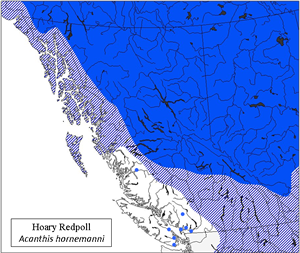This species is very similar to the Common Redpoll in all plumages, and its separation from that much more common species is relatively complex; caution is advised with any identification of this species in areas where it does not normally occur. Structurally, Hoary Redpoll averages slightly bulkier than Common Redpoll, with a slightly shorter, stubbier bill and steeper forehead (giving the bird the appearance of having a ‘pushed-in’ face), but these structural characteristics can often be difficult to assess accurately in the field. All plumages average whiter and ‘frostier’ overall than Common Redpoll, but particularly brown females and immatures can be very similar in colouration to bright Common Redpolls. Adult males are the most easily-identified plumage, and are typically the plumage that is reported throughout most of B.C. (due to its more obvious plumage characteristics). These individuals are very white overall (often likened to ‘snowballs’ or, when in flight, ‘snowflakes’), much more so than even the palest Common Redpolls, and this feature alone should be sufficient to bring attention to a potential male Hoary Redpoll in a flock of Commons. Additional field marks of Hoary Redpoll include the virtually unstreaked white rump (rump usually streaked with brown in Common Redpoll), very narrow and much less extensive brown streaking on the sides and flanks (streaking darker, broader, and more extensive in Common Redpoll), the virtual lack of narrow brown streaks on the undertail coverts (whitest Common Redpolls always with at least a few narrow dark streaks), and less extensive and usually paler pink suffusion on the breast. Female and immature Hoary Redpolls are much less obvious than adult males, and many of their identifying field marks are much more subtle. They still average paler and ‘frostier’ than Common Redpoll however, with broader white wing bars and secondary feather edges, white frosting on the rear scapulars (absent in Common Redpoll), usually unstreaked white rump, and narrower and less extensive brown streaking on the sides, flanks, and undertail coverts (most immature and female Common Redpolls with extensive dark streaking on the undertail coverts). In addition, Hoary Redpolls tend to show a somewhat paler peachy-buff wash on the face and head the darker and more extensive buff wash over the head, breast, and sides of most immature and female Common Redpolls. Particularly dull, brown immature Hoary Redpolls do approach unusually white female Common Redpolls, however, and some individuals may be extremely difficult to separate.
Source: Sibley (2000); Rosenberg (2006b)
| Although subtle differences in voice do exist, the vocalizations of Hoary Redpoll are considered more or less identical to those of Common. Furthermore, this species usually occurs as one or a few individuals within a larger flock of Common Redpolls, thus the minor differences in vocalizations are unlikely to be audible amongst the overwhelming chatter of the surrounding Common Redpolls. The male’s song is a series of short, repeated notes and short trills, usually incorporating call notes: che, che, che, tchrrrrr, chit, chit, chireeee. This species abandons its wintering grounds early in the spring, however, and singing males are unlikely to be detected in this province. The commonly-heard call is a series of short, dry notes (sometimes given singly), each note with a slightly descending pattern: chif, chif, chif, chif; this call is very similar to Common Redpoll, but may average slightly lower-pitched and softer. It also gives a wiry, drawn-out, nasal juwee with a rising inflection; this call is very similar an analogous call of the Common Redpoll, but averages slightly lower-pitched and simpler. Source: Knox and Lowther (2000); Sibley (2000) |
The Hoary Redpoll is a non-breeding winter visitor to British Columbia.
|
Foraging habits are almost identical to those of Common Redpoll, with which it is usually found in B.C. During migration and winter, the Hoary Redpoll forages almost entirely on the small seeds of certain trees, shrubs, weeds, and grasses. In forested habitats, it appears to prefer the seeds of birch and alder catkins, although it also extracts seeds from willow catkins and, occasionally, conifer cones. When foraging in trees, it often occurs near the tips of the branches where it extracts seeds from fruits and catkins. It often feeds acrobatically, hanging upside down, and is very active during foraging periods. It also picks seeds from the ground or clambers among the stems of grasses and weeds to extract seeds from the spent flowering heads. It sometimes visits bird feeding stations in suburban and rural environments, usually in the company of larger flocks of Common Redpolls.
Source: Knox and Lowther (2000); Campbell et al. (2001)
|
|

